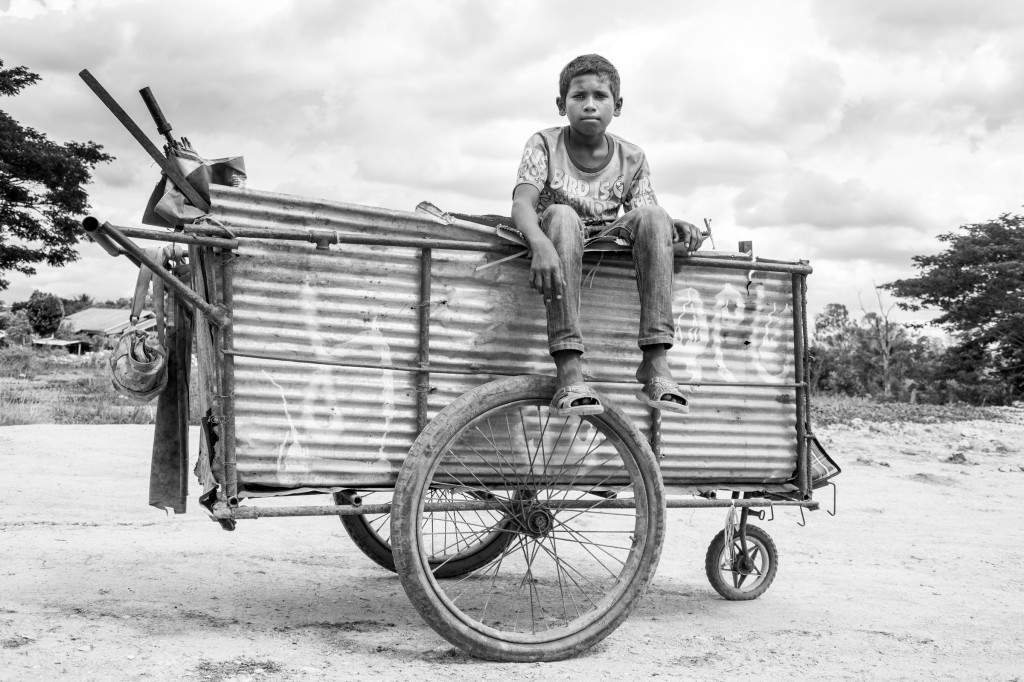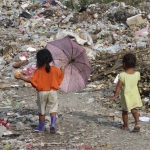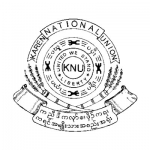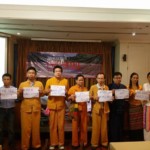Karen News, June 12, 2014
Child migrant workers in the Thai-Burma border town of Mae Sot struggle to earn enough to survive, working in dirty, difficult and dangerous work, many miss out on an education and are vulnerable to exploitation. To mark World Day Against Child Labour, Karen News followed the story of one of Mae Sot’s child migrant workers, a garbage collector.
Ali, 10, walks down the Asia Highway in the midday sun, garbage cart in tow, heavily laden trucks barrel past transporting goods to Burma.
Ali takes a break, taking refuge from the heat under a small tree beside the highway. “I want to go back to school,” he says sitting on his half-full garbage cart.
“Almost all of my friends are going to school, but I can’t… I don’t get to see my friends much because they are at school,” Ali says, “I want to go to school, but I need to help my mum.”
Each day he walks the seven kilometers to the Friendship Bridge that straddles the Moei River on the Thai-Burma border, and then back again, filling his cart with scrap metal, cardboard and bottles, to sell at a dumpsite in town.
Last year Ali had to drop out of school to help his mother as a garbage collector. Everyday they start work around 5am. For a full day’s work helping his mother he earns 10 baht in pocket money. His mother says that they might earn 80 baht (US$2.50) for a full day’s work.
The National Health Commission Office of Thailand on its website estimates that the number of migrant workers currently in Thailand is four million. According to a 2011 report by the Committee for Protection and Promotion of Child Rights in Burma (CPPCR) there are an estimated 200,000 migrant children younger than 17 in Thailand -– of which less than one third have access to education.
Ko Naing Min, Director of the CPPCR, which aims to safeguard the welfare of migrant children in the Mae Sot area, stated in a an interview with Karen News that as many as half of migrant children in Mae Sot did not go to school, often because they had to help their parents with work.
“According to our estimates we can say that there is between 28,000 to 30,000 migrant children in the Mae Sot area. 14,000 of them don’t attend school making them more at risk to things like sexual abuses, exploitation, child labour and accidents (like getting hit by trucks).”
Ko Naing Min confirmed to Karen News these cases were on the increase and that the risks were greater for migrant children, saying the “root cause” of risks to migrant children was a lack of documentation. He said that Thai authorities had a “duty” to ensure that migrant children had documentation as to guarantee that they were “protected fully by the laws.”
Ali’s mother, Soe Win, says that life is tough in Mae Sot since they moved from the Burma city of Mawlamyine four years ago. “Life is very hard here, we have to work hard to survive and expenses are high. Just for electricity and rent we need to pay 1,600 baht every month,” as undocumented workers, she said that they lived everyday in fear of Thai police deporting them from the country. “Our biggest difficulty is the police, they could arrest us at any time and send us back.”
A survey of nearly 800 Mae Sot migrant workers by the International Rescue Committee (IRC) and Tufts University in 2012 found that, “One in five migrants experienced eviction, one in ten suffered physical assault, and one in six was a victim of theft. More than a third of the migrants live in unsafe or unsanitary housing.”
Under the UN Declaration of Human Rights, the children accompanying their parents across the border as well as those born stateless in Thailand have a universal right to education. In 2005 the Thai government passed a resolution, stating that all children living in Thailand should have access to education regardless of race, nationality or legal status. But for thousands just like Ali, this fails to become reality.
“If I get an education I want to become a doctor, I want to study medicine in Burma,” Ali says, “but I can’t, and this makes me feel sad.”
This news story originally appeared on Karen News. See the original here.







